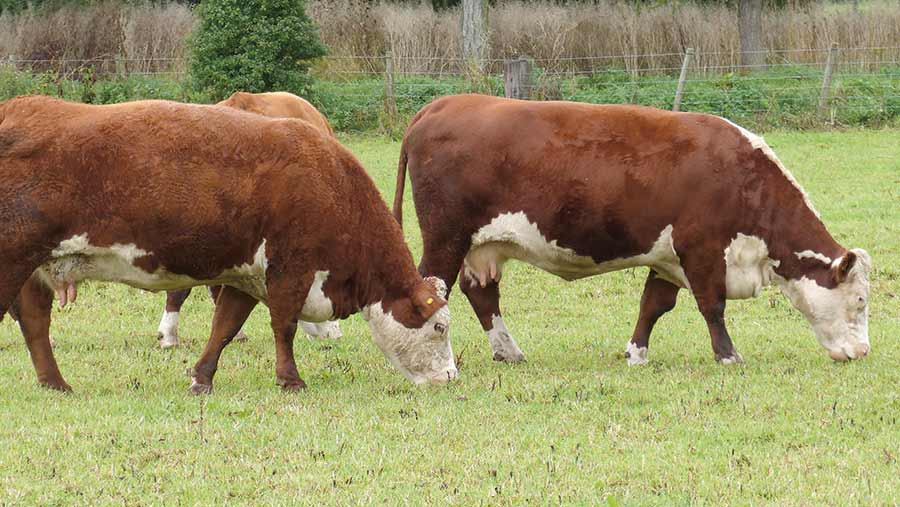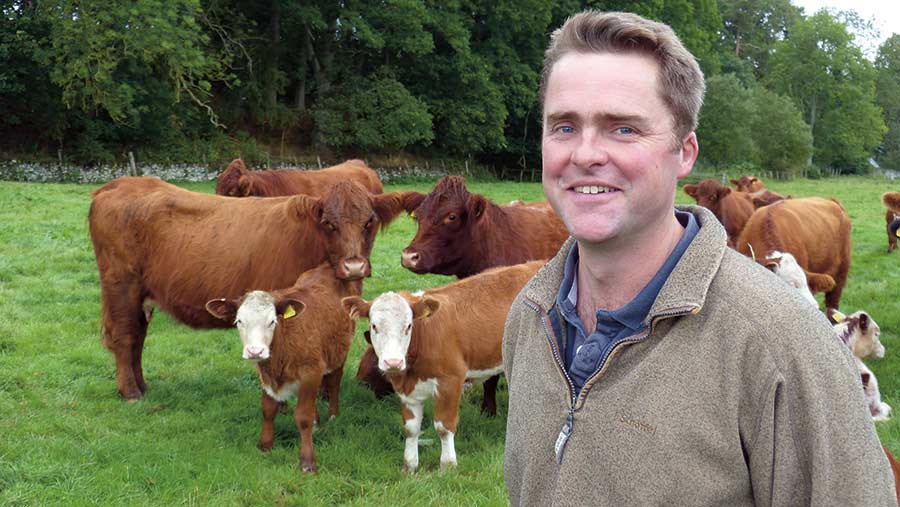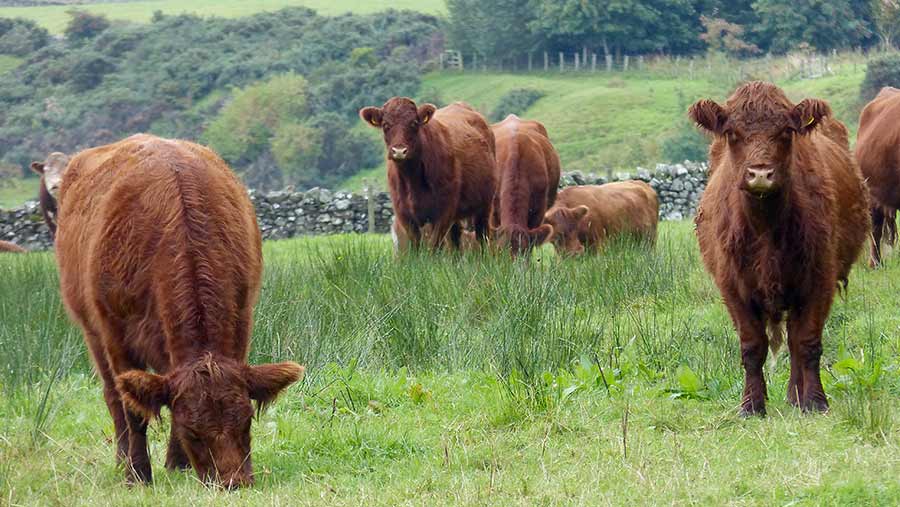How a Hereford breeder is increasing cow efficiency

A Scottish Borders farming family has seen a 15% increase in the number of cows weaning 50% of their weight in the past 10 years.
The Wilson family of Cowbog farm, Morebattle, has bred Hereford cattle since 1955, and back in 2008 was seeing 40% of their cows hit a weaning efficiency figure of 50% or more.
However, now Breedplan figures show that 55% of the herd is weaning half of its weight, with the best cow weaning 62% of its weight by the 200-day mark.
See also: Is bigger better when it comes to cow size?
Farm Facts
- 182ha across three Roxburghe Estate Farms
- 76.5ha permanent pasture
- 105.6ha arable or five-year grass leys
- Growing malting barleys, feed wheat and wholecrop barley
- 61 purebred Hereford cows and followers
- 35 Highland-cross Shorthorn recipients and followers
- Fluffy Moos: An onfarm diversification offering a range of team building/bonding days, all based around farm activities, including training courses with the pedigree Herefords for those new to pedigree livestock.
With average cow weight at 800kg, this means 55% of the 61 pure-bred Hereford cows are weaning a calf weighing 400kg or more.
“Maternal ability is something we’ve really started to work on in the last 10 years,” explains tenant farmer Rob Wilson. “And since 2014 we’ve started to see gains in both the EBVs and calf growth.”

Rob Wilson
While creep feeding and quality forage have helped cows and calves perform well, these have long been constants in the farming system, with Mr Wilson attributing the improvements largely to genetic progress.
Herd management at Cowbog
Grassland management
- Fixed stocking, grazing pure-bred cattle from April to mid-November when cows are housed.
- Forward-graze calves on the next pasture by using creep feeders on gateways feeding an 18% protein nut.
- Some Hereford cows will be outwintered on stubbles and grass silage bales this year to eke out silage and bedding supplies.
Hereford herd breeding and management
- Breeding done through natural service at about one bull to 30 cows due to shed size.
- Purebreds are bulled inside from Christmas onwards for 12-14 weeks to calve in September to December.
- Hereford heifers calve at 24 months old.
- Easy-calving bulls are used on heifers with multiple group mating seeing some bulls serve more than 30 females.
- Bull calves that don’t make breeding standard (50%) are kept entire and finished on a deadweight contract at around 330kg to AK Stoddarts in less than 16 months.
- Cows are fed silage (10-11ME, 70 D-value) through the winter.
- Cows calve inside with cameras and only 3-4% need assistance of any kind (three backwards calves last year).
Improving maternal efficiency
Alongside a strict culling policy on correctness, milking ability, lameness and udders, two bulls have made a big impact in the younger cows.
Baybridge 1 Atlas by the Australian stud sire Doonbiddie Hustler was bought in 2005 to improve udder structure and breed milky daughters.
Then, in 2008, a Danish-bred bull called SMH Castro was bought at five months old. He went on to produce easy-calving daughters, with impressive growth and milk figures that are still above the breed average 11 years after he was born.
Now a senior stock herd sire, Barwise 1 Lancer (2018 Hereford sire of the year), is maintaining progress, being in the top 1% for the terminal and self-replacing index. He is from an embryo from an Argentinian sire and a Canadian dam.
Improving terminal traits
In addition to maternal ability improving, carcass traits have also held or improved, Mr Wilson explains.
EBVs for retail beef yield, intramuscular fat, eye muscle area and carcass weight are all well ahead of the breed average and the herd’s terminal index is at +31, above the breed average of +25.
Future improvements: ET work
An ET programme using health scheme accredited Highland-cross Shorthorns as recipient females is the next step to improving maternal efficiency into the future.

The Highland-cross Shorthorn herd
The 35-head recipient herd was bought as heifers from Iain Graham’s Killochries fold, Kilmarnock, last year.
Mr Wilson knows the cattle will be well-bred, hardy and low-cost, and he hopes to achieve a sensible target of 50% of frozen embryos holding and any failed pregnancies to result in a Hereford-cross calf for the prime market.
Timeline at Cowbog |
|
|
February/March 2017 Cattle introduced to Cowbog |
35 two-year-old heifers were fluke-drenched, wormed and mineral bolused, and put on grass. |
|
Spring 2017 Rising plane of nutrition |
Recipients kept outside to minimise the change from their upland environment. Grazed and buffer fed 2kg/head/day of beet pulp for a month either side of ET taking place. |
|
Summer 2017 Selecting heifers for ET work |
ET work was carried out on 27. Eight crossbreds found to have small corpus luteums and so were unsuitable for ET work. |
|
July-August 2017 Embryo transfer and sweeping up |
The herd scanned with 14/27 live embryos and had 12 live pure Hereford calves on the ground in April 2018. An easy-calving homozygous-polled Hereford bull ran with the herd, resulting in a further 21 Hereford-cross calves, with two barren heifers. |
|
Winter 2017-18 Low-cost wintering |
Crossbreds received 400kg of wholecrop silage each for 160-day winter, while wintered on arable stubbles. 8ha of kale/stubble turnip hybrid has been sown for 2018-19 wintering. In February and March 0.47kg/head/day of cow pellets were fed to help milk and colostrum production. |
|
April 2018 Calving success |
33 recipients calved down at 400-600kg, with only one malpresentation needing assistance. Going forward, any retained cleansings or difficult calvings will be culled. |
Future Improvements: Genetic selection
Cows were selected for flushing on EBVs for milk, growth and self-replacing index and family lines. Most were Romany dam lines, but some dam lines have come from outside the herd.
Dam selection is aiming to use younger cows, to keep genetic progress up, although some older cows have been flushed due to them being proven and having more daughters on the ground, Mr Wilson says.
No ET work was done this year, because the hot weather and difficult spring decreased the likelihood of successful pregnancies due to stress on the recipient cows.
However, the Wilsons are hoping for kinder weather in 2019 to transfer embryos into the recipient herd, for another calf crop in 2020.
Looking ahead, in-vitro fertilisation (IVF) and genomics will both be used to increase genetic gain in the herd.
Mr Wilson says: “IVF seems increasingly successful in other herds and we will look to use it in the future. It is less obtrusive for the donor cow and can be undertaken more frequently.
“Although there are increased costs, one good new cow family or stock bull pays for it all, especially with the low-cost recipients we are running.”
Genomics is the other thing the Wilsons are keen to start using. Work is under way on the Hereford Cattle Society genetic database which will allow genomic testing to be introduced within the society.
